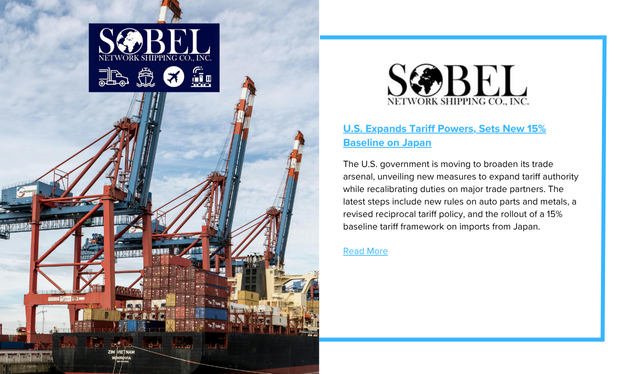The U.S. government is moving to broaden its trade arsenal, unveiling new measures to expand tariff authority while recalibrating duties on major trade partners. The latest steps include new rules on auto parts and metals, a revised reciprocal tariff policy, and the rollout of a 15% baseline tariff framework on imports from Japan.
Section 232 Expansion Targets Auto Parts and Metals
On Sept. 17, the Department of Commerce published an interim final rule creating a new petition process for U.S. producers seeking higher tariffs on imported cars and auto parts under Section 232. The existing tariff rate of 25% can now be extended to additional components if industry groups successfully file requests.
The inclusion process will operate on a quarterly basis, with the first filing window open through Oct. 14. A parallel process for steel and aluminum downstream products will close on Sept. 29. Following each window, the Department of Commerce will allow two weeks for public comments before decisions are finalized.
The White House framed the move as essential to protecting national security and strengthening domestic supply chains, emphasizing its goal of reducing reliance on foreign manufacturing in critical industries.
Pushback From Industry
Business groups have raised concerns that the expanded process risks adding compliance burdens and costs across multiple sectors. In a Sept. 16 letter organized by the U.S. Chamber of Commerce, more than 40 trade associations warned that many manufacturers rely on imports of goods not readily available domestically.
“The sudden expansion of tariffs with limited consultation increases costs by generating significant compliance burdens,” the letter said. “The harm to U.S. employment among downstream producers will ultimately be significant, particularly in industries vital to national competitiveness.”
Reciprocal Tariffs and Targeted Adjustments
The administration also updated its reciprocal tariff policy, first launched in April 2025 to address U.S. trade deficits. A Sept. 5 executive order broadened the scope of covered products—adding items such as aluminum hydroxide, resin, and silicone—and created a new annex for “Potential Tariff Adjustments for Aligned Partners.”
Under this mechanism, lower tariff rates may be applied to selected goods, including aircraft parts and agricultural commodities, if partner nations sign agreements that address reciprocity and national security concerns.
15% Baseline Tariff on Japan
In a parallel development, a U.S.-Japan trade agreement has taken effect in stages since August, setting a 15% baseline tariff on most Japanese imports. Sector-specific provisions apply to industries such as autos, aerospace, and pharmaceuticals.
The deal places Japan in the same tariff tier as South Korea, while higher rates remain in place for other major U.S. trade partners. Current tariff levels include:
-
Brazil, India: 50%
-
Laos: 40%
-
Switzerland: 39%
-
Canada: 35%
-
China, South Africa: 30%
-
Mexico: 25%
-
Japan, South Korea: 15%
Broader Implications
With tariffs now touching imports from more than 90 countries, the United States is reshaping trade dynamics on a global scale. Supporters say the policies are designed to bolster domestic industries and safeguard national security, while critics argue they risk destabilizing supply chains, raising consumer prices, and straining relations with key partners.
As these measures roll out, manufacturers and importers will need to navigate heightened uncertainty, balancing compliance costs with the potential long-term benefits of a more self-reliant U.S. industrial base.


